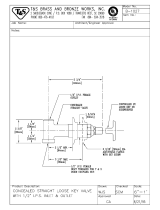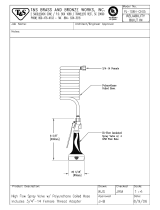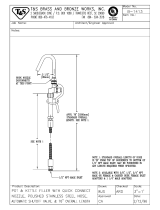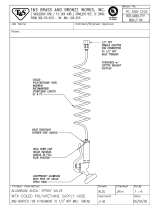Page is loading ...

A Pocket Guide to Air-Line Systems

Introduction
1
Current air-line systems fall into two categories: pressure-demand
and constant ow. The difference between the two is how air is
supplied.
Pressure-demand systems deliver air only when the user
necessitates it. Thus, pressure-demand devices afford greater air
supply efficiency.
In contrast, with a constant ow device, air ow to the respirator
is continuous. However, because air ow is continuous, constant
ow air-line systems are generally used with a compressor for a
virtually unlimited air supply.
Type-C supplied-air respirators are approved by the National
Institute for Occupational Safety and Health (NIOSH) and the
Mine Safety and Health Administration (MSHA) for use in
atmospheres not immediately dangerous to life and health or
from which the wearer can escape without wearing the respirator.
Type-C supplied-air respirators, more commonly referred to as
air-line respirators, are designed to pro vide long-duration
respiratory pro tec tion.
These respirators generally consist of a full-facepiece or half-
mask facepiece con nect ed by air-supply hose to an air source
(either a compressor or bank of large air cylinders). When
connected to the air source, the respirator delivers a supply of
re spi ra ble air to the user.
Accessory equipment, such as pressure regulators, pressure relief
valves, carbon monoxide monitors, and lters for air com pres -
sors, may be necessary to ensure that air is at the proper pressure
and quality for breathing. Air quality must be Quality Verication
Level Grade D or better as dened in ANSI Standard Z-86.1-1973
(Compressed Gas Association Specication G-7.1 Commodity
Spec i ca tion for Air).

2
Type C supplied-air respirators equipped with an auxiliary escape
cylinder are approved for use in IDLH atmospheres.
“Immediately dangerous to life and health” means any
haz ard ous atmosphere that may produce physical discomfort
im me di ate ly, chronic poisoning after repeated exposure or acute
adverse physiological symptoms after prolonged exposure.
(42 CFR, Part 84 subpart A, 84.2(x)).
This limitation is necessary because the air-line respirator
depends entirely upon an air supply not carried by the wearer.
Therefore, if the air hose were severed or crimped, or the air
compressor failed, the air supply to the wearer would be shut off.
The wearer would be without respiratory protection and might
not be able to safely escape from an IDLH atmosphere.
Another limitation of air-line respirators is that air-supply hose
limits the wearer to a xed distance from the air source.
As an air-line respirator user, it is your responsibility to supply the
respirator with breathable air — Type 1-Grade D or better. The
following pages show complete hookups of various air-line
systems, both pressure-demand and constant ow, from air
source to respirator, to aid you in assembling your own
air-line system.
Product user manuals must be reviewed prior to use of
equipment. This document is not intended to be the sole
source of guidance for determining appropriate supplied-air
setup and conguration.

Pressure-Demand Air-Line Respirators
3
Pressure-demand air-line respirators are designed to maintain
slight positive air pressure inside the facepiece whether the
wearer is inhaling or exhaling. This design helps to prevent
contaminants from seeping in around the facepiece, even if
there should be small breaks in the face-to-facepiece seal.
Pressure-demand air-line respirators are designed specically for
non-IDLH toxic atmospheres. The exception is if the respirator is
equipped with an egress air cylinder for use during escape.
Pressure-demand air-line units require an air supply from an
uncontaminated compressed-air source as stipulated in General
Industry Safety and Health Regulations, Part 1910.134 (OSHA)
with delivered air conforming to at least Type 1-Grade D of ANSI
Standard Z86.1.
A common air source for pressure-demand systems is a single air
cylinder that can be set up in remote sites that might otherwise
be impossible to reach with a large stationary compressor.
Another air source option for pressure-demand respirators is a
cylinder cascade system. A cascade system consists of several air
cylinders joined together in a bank by means of coupler tees.
Generally, banks consist of 3 cylinders of either 244 cubic-feet or
330 cubic-feet-capacity. One or more workers can breathe from
a cascade system.
Average consumption of air is approximately 1.5 cubic feet of air
per person, per minute. At a normal rate of consumption, a
3-cylinder bank used with a pressure-demand unit provides
between 8 to 12 man-hours of air, depending upon cylinder
capacity.
If using a compressor system, each respirator requires 1.5 cfm
per person and needs to maintain inlet (working) pressure
specied in the respirator instruction manual.

MSA Pressure-Demand Air-Line Units Include:
4
To congure these products, please visit our air-line selection guide:
http://webapps.msasafety.com/product-selection-guide/airline/#/index
• PremAire® Pressure-Demand Air-Line Respirator System:
• with escape cylinder (for egress from IDLH atmospheres)
• with vortex tube (for suit-cooling applications)
• with dual-supply (to eliminate additional hose lengths)
• PremAire Cadet Supplied-Air Respirator
(for use in non-IDLH environments)
• PremAire Cadet Escape Respirator/G1 PremAire Cadet Escape
(for use in and escape from IDLH atmospheres)
PremAire Pressure Demand
Airline Respirator System
PremAire Cadet Escape
Respirator
MSA G1 PremAire
Cadet Escape

Cylinder and Cylinder Cascade Systems
5
Sealing tape required on all pipe threads. Begin at
second thread and wrap 1 to 1-1/2 turns clockwise.
Do Not use on straight threaded connections with
O-ring seals. (Example: Airline hoses have straight
threaded connections. See page 27).
Industry standards suggest tightening a pipe threaded connection so that 3-5 threads are exposed. (MSA has found that 8-12 ft-lbs. is suitable for our pipe thread applications).

6
1* Air cylinder – NOT SUPPLIED BY MSA
(A) Air tee block – (see pg. 20)
(B) Air pigtail – (see pg. 20)
(C) Audi-Larm™ Audible Alarm – (see pg. 19)
(D) Air cylinder pressure regulator – (see pg. 19)
Outlet Connections:
(E1) Female socket – P/N varies with type
(see pgs. 28 & 29 – col. 1)
Nipple – 1/4" x 1/4" NPT – (needed only w/female socket)
P/N 459867
(E2) 2-outlet manifold: (see pg. 21)
(E3) 4-outlet manifold: (see pg. 21)
(F) Male plug with female 1/4" NPT –
P/N varies with type (see pgs. 28 & 29 – col. 2)
(G) Union adapter – (see pgs. 28 & 29 – col. 3)
(H) MSA air-supply hose –
P/N varies with type (see pg. 27)
(I) Locking quick-disconnect female socket –
P/N varies with type (see pgs. 23 & 24)
(J) Locking quick-disconnect male plug –
P/N varies with type (see pgs. 23 & 24)
(K) Female socket assembly –
P/N varies with type (see pgs. 28 & 29 – col. 4)

7
Industrial Air Cart
Industrial Air Cart permits as many as 4 NIOSH-approved air-line
respirators to be connected to 2 1-hour 4,500 psig breathing
apparatus cylinders (not included). See table below for cylinder
ordering information. 60-minute cylinder provides maximum
air supply.
INDUSTRIAL
AIR CART
10107537 Industrial air cart equipped with
union adapters
10107779 Industrial air cart equipped with
Snap-Tite aluminum quick-disconnects
10107780 Industrial air cart equipped with
Foster steel quick-disconnects
10107811 Industrial air cart equipped with
Hansen brass quick-disconnects
Provides air for up to
four pressure-demand
air-line respirators.

TransportAire™ Portable Air-Supply System
8
High pressure – P/N 812217

9
(D) Male plug with female 1/4'' NPT –
P/N varies with type (see pgs. 28 & 29 – col. 2)
(E) Union adapter –
P/N 69542 (see pgs. 28 & 29 – col 3.)
(F) MSA air-supply hose –
P/N varies with type (see pg. 27)
(G) Locking quick-disconnect female socket –
P/N varies with type (see pgs. 23 and 24)
(H) Locking quick-disconnect male plug –
P/N varies with type (see pgs. 23 and 24)
(I) Female socket assembly –
P/N varies with type (see pgs. 28 & 29 – col. 4)
TransportAire Portable Air-Supply System consists of an impact-
resistant handle with nylon straps that t around a variety of
MSA breathing apparatus cylinders (purchased separately).
System is designed exclusively for use with MSA supplied-air
respirators equipped with dual-supply option.
• 2 options
• Can connect air-line hose directly to tting (P/N 628232)
from 21'' hose that is included with TransportAire System,
or can use quick-disconnect ttings.

10
CYLINDERS 10127944SP H-30SL*, SuperLite, 30-minute NIOSH service life rating, 4500 psig, weight (empty): 6 lb. 9 oz.
807570 H-45* Carbon-wrapped, 45-minute NIOSH service life rating, 4500 psig, weight (empty): 9 lb. 7 oz.
10127945SP H-45SL, SuperLite, 45-minute NIOSH service life rating, 4500 psig, weight (empty): 8 lb. 8 oz.
10127946SP H-60SL*, SuperLite, 60-minute NIOSH service life rating, 4500 psig, weight (empty): 10 lb. 12 oz.
* These cylinders are capable of custom options. Contact MSA Customer Service at 1-800-MSA-2222 for more information. All weights are approximate.
MSA Cylinders

Constant Flow Air-Line Respirators
11
Constant ow air-line respirators also maintain slight positive
air pressure inside the facepiece whether the wearer is inhaling
or exhaling. This design helps to prevent contaminants from
seeping in around the facepiece, even if there should be small
breaks in the face-to-facepiece seal.
Constant ow air-line respirators maintain air ow at all times,
rather than only on demand. Because of this design, constant
ow units almost always use a compressor as their air source.
A constant ow unit would quickly exhaust air from a cylinder
or cascade system.
There are two types of constant ow air-line respirators: one uses
a tight-tting facepiece; the other, a loose-tting hood or
helmet. Inlet air pressure must be able to maintain at least 4 cfm
for a tight-tting facepiece and 6 cfm for a loose-tting hood.
Inlet pressure for constant ow air-line respirators varies
between 10-15 psig for low-pressure systems and 35-40 psig
for high-pressure systems.
For constant ow air-line hoods, inlet pressure usually ranges
between 10-15 psig and 85-100 psig, depending upon type.
Also, depending upon inlet pressure, the length of approved
air-supply hose for these systems is usually between
8-50 feet for low-pressure systems and 8-300 feet for high-
pressure systems. Consult the instruction manual for your
respirator to determine specic inlet pressure and hose length.

12
Abrasi-Blast Supplied-Air Respirator
MSA Constant Flow Respirators
MSA Constant Flow respirators include:
• Duo-Twin respirators
• Abrasi-Blast supplied-Air respirator
• Constant Flow respirators with
Advantage 4100, Ultra Elite,
or Comfo facepieces
Duo-Twin Respirator with Advantage 4000 Facepiece

Regulated Plant Compressor System
* Note: Inlet pressure gauge is required if there is a distance of 10-ft or more between the regulator and the manifold.
L
o
c
k
i
n
g
q
u
i
c
k
-
d
i
s
c
o
n
n
e
c
t
G2
1*
A B CD
E
F
H J K
G1
G3
REGULATED
PLANT AIR
COMPRESSOR
S
e
l
e
c
t
o
n
e
o
u
t
l
e
t
c
o
n
n
e
c
t
i
o
n
:
G
1
,
G
2
,
o
r
G
3
I
L
M
N
13

14
1* Plant air compressor – NOT SUPPLIED BY MSA
(A) Outlet tting for system – varies with system –
contact MSA for more information and guidelines
(B) Nipple (1/2 x 1/2 x 1 1/2 NPT) – P/N 68833
(C) Air-line lter–P/N 81857 (see pg. 18)
(E) Pressure regulator – P/N 66716 (see pg. 18)
(F) Bushing (1/2" M x 1/4" F) – P/N 625528
Outlet Connections:
(G1) Female socket – P/N varies with type (see pgs. 28 & 29– col. 1)
Nipple – 1/4" x 1/4" NPT – (needed only w/female socket)
P/N 459867
(G2) 2-outlet manifold: (see pg. 21)
(G3) 4-outlet manifold: (see pg. 21)
(H) Male plug with male 1/4" NPT
(I) MSA inlet pressure gauge (see pg. 22)
(J) Union adapter (see pgs. 28 & 29 – col. 3)
(K) MSA air-supply hose –
P/N varies with type (see pg. 27)
(L) Locking quick-disconnect female socket –
P/N varies with type (see pgs. 23 & 24)
(M)Locking quick-disconnect male plug –
P/N varies with type (see pgs. 23 & 24)
(N) Female socket assembly –
P/N varies with type (see pgs. 28 & 29 – col. 4)

Breathing Air Distribution System Filtration Box
15
Breathing Air Distribution System
ltration box is housed in a rugged
polymer case. Unit is equipped with
3-stage ltration, pressure regulator,
4-outlet manifold, and continuous ow
115 VAC carbon monoxide monitor.
Filtration box may be used in portable or
stationary position. Two models of
ltration box are available:
1– provides 50 cubic feet of air per
minute;
2– provides 100 cubic feet of air per
minute.
Portable Grade-D ltration system
provides breathing air for up to
4 air-line respirators.
For use in the United States
Carbon monoxide
monitor set at 10 ppm
For use in Canada
Carbon monoxide
monitor set at 5 ppm
Outlet Connections
FILTRATION
BOXES
50 CFM
10107538 10113347 Union adapters
10107814 10113349 Snap-Tite aluminum
quick-disconnects
10107812 10113348 Foster steel
quick-disconnects
10107813 10113346 Hansen brass
quick-disconnects
FILTRATION
BOXES
100 CFM
10107539 10113345 Union adapters
10107816 10113343 Snap-Tite aluminum
quick-disconnects
10107817 10113342 Foster steel
quick-disconnects
10107815 10113344 Hansen brass
quick-disconnects

Hose Reel Assembly
16
A = 20 7/8'' deep
B = 21 7/8'' tall by 10 1/2'' wide
Includes 50-ft. 3/8'' neoprene airline hose P/N 455022.*
Automatically keeps hose at any desired length, controlling
slack. Hose reel assembly – P/N 72444
A
B
E
C
D
F
(A) Air-cylinder pressure regulator, dual gauge (see pg. 19)
(B) Union adapter 1/4'' NPT male x 3/4'' UNF female – P/N 69541
(C) * 8' neoprene hose – P/N 481071 (see pg. 27)
(D) 3/4'' UNF male x 1/4'' NPT male – P/N 69542
(E) Pipe bushing 1/4'' NPT female x 1/2'' NPT male – P/N 625528
(F) Female socket assembly – P/N varies with type
(see pgs. 28 & 29 – col. 4)
* 3/8'' air-line hose has 3/4'' UNF threads.

NIOSH Approvals
17
NIOSH approves air-line respirators per 42 CFR Part 84, Subpart J.
Approval is sought by respirator manufacturers for specic hose
lengths and inlet pressures. An approved air-line respirator
includes hose, ttings and respirator.
Most MSA pressure-demand air-line units are NIOSH-certied
for operation at 65-85 psig with 25 to 300 feet of approved MSA
air-supply hose.
However, respirators that are part of the PremAire System,
including the PremAire Cadet Respirator, are NIOSH certied
for op er a tion at 60-100 psig with 8 to 300 feet of approved hose.
(No more than 12 sections of hose may be used, or 6 sections
when using coiled hose).
The MSA Constant Flow Air-line Respirator has high-pressure
NIOSH certication of 35-40 psig with 8 to 300 feet of approved
hose, and low-pressure certication of 10-15 psig with 8 to 50
feet of approved hose.
Inlet pressure and hose lengths may vary by MSA product. You
must review the specic product user manual to understand
appropriate operating pressure and approved hose lengths.
Caution: Always refer to the specic product user manual
for exact pressure ranges.

18
Air-Line Filter
MSA air-line lter provides high-efficiency ltration of air stream
after it leaves the compressor. Minimum 99 percent removal of
0.3 micron and larger particulates including dusts, mists, fumes,
smoke, and petroleum vapors. A chemical cartridge removes
organic vapors. MSA air-line lter does not remove carbon
monoxide, and can be used at inlet pressures of up to
125 psig. Pressure
drop is 1 psig at
maximum rated air
ow of 25 cfm.
Pressure Regulator
MSA pressure regulator reduces plant air system compressor
pressure to desired operating pressure for respirators being
used. Maintains pressure on outlet side until re-adjusted for use
with inlet pressures of up to 125 psig.
PRESSURE REGULATOR 66716 Pressure regulator
AIRLINE
FILTER
81857 Air-line lter - with 1/2" NPT female inlet and outlet
488041 Air-line lter - with 3/4"-16 straight threads
484923 Replacement lter kit

19
Audi-Larm® Warning Device
Air-supply cylinders can be equipped
with the Audi-Larm Audible Alarm low-
pressure warning device. This warning
device uses a loud, clear bell to signal
the user when cylinder air supply has
been reduced to a limited service time.
The bell rings when cylinder pressure
reaches approximately 400 psig, and
also rings briey every time the cylinder is pressurized to check
proper alarm operation.
AUDILARM
AUDIBLE
ALARM
85078 Audi-Larm Audible Alarm assembly
(up to 3000 psig)
492307 High-pressure Audi-Larm Audible Alarm
assembly (up to 5500 psig)
Air-Cylinder Pressure Regulator
An air-cylinder pressure regulator is a
required accessory when air-line
respirators operate from a cylinder.
Dual-gauge regulator receives varying
outlet pressure from cylinder, reduces it
and regulates it to a constant pressure
of approximately 80 psig, the optimum
pressure for regulator operation.
AIRCYLINDER
PRESSURE
REGULATOR
68858 Air-cylinder pressure regulator,
dual-gauge, 0-3000 psig
633352 High-pressure air-cylinder reg u la tor,
dual-gauge, 0-5, 500 psig
/













